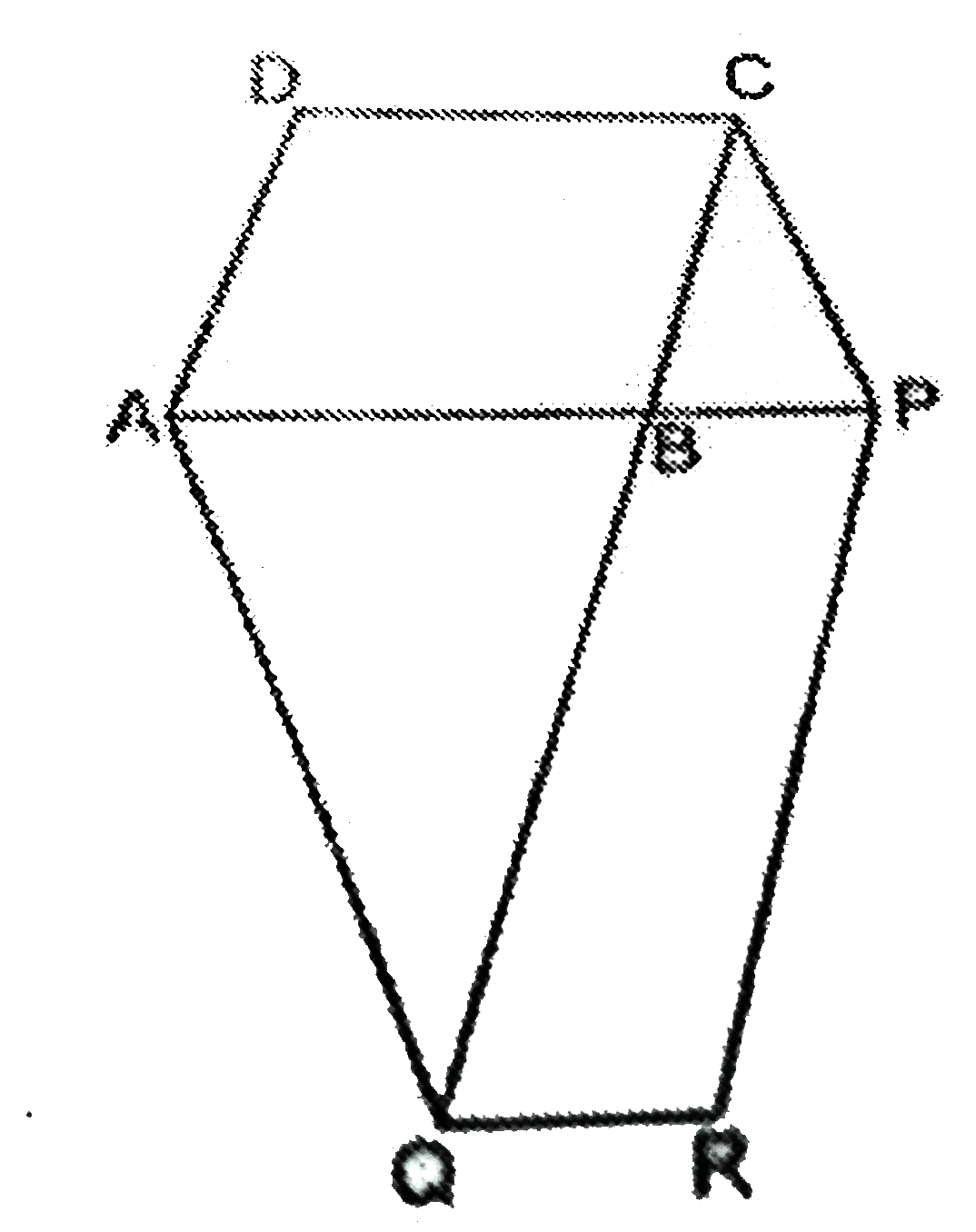The side AB of a parallelogram ABCD is produced to any point P. A line through A and parallel to CP meets CB produced at Q and then parallelogram PBQR is completed . Show that ar (ABCD) = ar (PBQR). [Hint : Join AC and PQ. Now compare ar (ACQ) and ar (APQ).]
![The side AB of a parallelogram ABCD is produced to any point P. A line through A and parallel to CP meets CB produced at Q and then parallelogram PBQR is completed . Show that ar (ABCD) = ar (PBQR). [Hint : Join AC and PQ. Now compare ar (ACQ) and ar (APQ).]](https://d10lpgp6xz60nq.cloudfront.net/physics_images/PSEB_ENG_MAT_IX_C09_E03_013_Q01.png) Solution in Punjabi
Solution in Punjabi
Step by step video & image solution for The side AB of a parallelogram ABCD is produced to any point P. A line through A and parallel to CP meets CB produced at Q and then parallelogram PBQR is completed . Show that ar (ABCD) = ar (PBQR). [Hint : Join AC and PQ. Now compare ar (ACQ) and ar (APQ).] by Maths experts to help you in doubts & scoring excellent marks in Class 9 exams.
Updated on:21/07/2023Topper's Solved these Questions
- AREAS OF PARALLELOGRAMS AND TRIANGLES BOOK - SWAN PUBLICATIONCHAPTER - AREAS OF PARALLELOGRAMS AND TRIANGLES EXERCISE - EXERCISE 9.4
21 Videos
- AREAS OF PARALLELOGRAMS AND TRIANGLES BOOK - SWAN PUBLICATIONCHAPTER - AREAS OF PARALLELOGRAMS AND TRIANGLES EXERCISE - OBJECTIVE TYPE QUESTIONS
20 Videos
- AREAS OF PARALLELOGRAMS AND TRIANGLES BOOK - SWAN PUBLICATIONCHAPTER - AREAS OF PARALLELOGRAMS AND TRIANGLES EXERCISE - EXERCISE 9.2
8 Videos
- CIRCLESBOOK - SWAN PUBLICATIONCHAPTER - CIRCLESEXERCISE - Objective Type Questions (Fill in the Blanks :)
10 Videos
Similar Questions
Parallelogram ABCD and rectangle ABEF are on the same base AB and have equal areas. Show that the perimeter of the parallelogram is greater than that of the rectangle.
View SolutionState whether the following statements are true (T) or false (F) :
If A and B are two congruent figures then their areas will be equal .
View SolutionIn Fig ., ABCD is parallologram , AE⊥DCandCF⊥AD . If AB= = 16 cm , AE = 8 cm and CF = 10 cm , find AD .

View Solution............... is the longest chord of the circle.
View SolutionThe side AB of a parallelogram ABCD is produced to any point P. A line through A and parallel to CP meets CB produced at Q and then parallelogram PBQR is completed. Show that ar (ABCD) = ar (PBQR).
View SolutionThe side AB of a parallelogram ABCD is produced to any point P. A line through A and parallel to CP meets CB produced at Q and then parallelogram PBQR is completed as shown in Figure. Show that ar(∣∣gmABCD)=ar(∣∣gmPBQR)
View Solutionसमांतर चतुर्भुज ABCD की एक भुजा AB को एक बिंदु P तक बढ़ाया गया है । A से होकर CP के समांतर खींची गई रेखा बढ़ाई गई CB को Q पर मिलती है और फिर समांतर चतुर्भुज PBQR को पूरा किया गया है ( देखिए आक्रति 9.26 )| दर्शाइए कि
ar(ABCD)=ar(PBQR) है |
View Solutionसमांतर चतुर्भुज ABCD की एक भुजा AB को एक बिन्दु P तक बढ़ाया गया है। A से होकर CP के समांतर खींची गई रेखा बढ़ाई गई CB को Q पर मिलती है और फिर समांतर चतुर्भुज PBQP को पूरा किया गया है (देखिए आकृति )। दर्शाइए कि (ABCD ) = क्षेत्रफल (PBQR ) है।

View Solutionसमांतर चतुर्भुज ABCD की भुजा AB को किसी बिंदु P तक बढ़ाया गया है। बिंदु A से CP के समांतर खींची गयी रेखा CB के आगे बढ़ाये गये भाग को Q पर मिलती है। और समांतर चतुर्भुज PBQR को पूरा करती है। सिद्ध कीजिए कि
ar(।।gmABCD)=ar(।।gmBPRQ)
View SolutionIn, ABCDE is a pentagon. A line through B parallel to AC meets DC produced at F. Show that
(i)ar (ACB) = ar (ACF)
(ii)ar (AEDF) = ar(ABCDE)

View SolutionThe side AB of a parallelogram ABCD is produced to any point P. A line through A and parallel to CP meets CB produced at Q and then parallelogram PBQR is completed . Show that ar (ABCD) = ar (PBQR)
View SolutionIn the figure, ABCDE is a pentagon. A line through B parallel to AC meets DC produced at F. Show that
(i) ar(ΔACB)=ar(ΔACF)
(ii) ar(AEDF)=ar(ABCDE)

View SolutionThe side AB of a parallelogram ABCD is produced to any point P. A line through A and parallel to CP meets CB produced at Q and then parallelogram PBQR is completed. Show that ar (ABCD) = ar (PBQR).
View SolutionThe side AB of a parallelogram ABCD is produced to any point P. A line through A and parallel to CP meets CB produced at Q and then parallelogram PBQR is completed as shown in Figure. Show that ar(∣∣gmABCD)=ar(∣∣gmPBQR)
View Solutionਚਿੱਤਰ 9.16 ਵਿਚ, ਸਮਾਂਤਰ ਚਤੁਰਭੁਜ ABCD ਦੇ ਅੰਦਰ ਸਥਿਤ ਕੋਈ ਬਿੰਦੂ P ਹੈ। ਦਰਸਾਉ ਕਿ (i) ar(APB)+ar(PCD)=12ar(ABCD) (ii) ar(APD)+ar(PBC)=ar(APB)+ar(PCD) [ਸੰਕੇਤ:-P ਵਿੱਚੋਂ ਲੰਘਦੀ AB ਦੇ ਸਮਾਂਤਰ ਇੱਕ ਰੇਖਾ ਖਿੱਚੋ।]

View Solutionਸਮਾਂਤਰ ਚਤੁਰਭੁਜ ABCD ਦੀ ਇੱਕ ਭੁਜਾ AB ਨੂੰ ਇੱਕ ਬਿੰਦੂ P ਤੱਕ ਵਧਾਇਆ ਗਿਆ ਹੈ। A ਵਿੱਚੋਂ ਲੰਘਦੀ CP ਦੇ ਸਮਾਂਤਰ ਖਿੱਚੀ ਗਈ ਰੇਖ, ਵਧਾਈ ਹੋਈ CB ਨੂੰ Q 'ਤੇ ਮਿਲਦੀ ਹੈ ਅਤੇ ਫਿਰ ਸਮਾਂਤਰ ਚਤੁਰਭੁਜ PBQR ਨੂੰ ਪੂਰਾ ਕੀਤਾ ਗਿਆ ਹੈ।(ਦੇਖੋ ਚਿੱਤਰ 9.26)। ਦਰਸਾਓ ਕਿ ar (ABCD) = ar (PBQR) ਹੈ। [ਸੰਕੇਤ: AC ਅਤੇ PQ ਨੂੰ ਮਿਲਾਓ। ਹੁਣ ar (ACQ) ਅਤੇ ar (APQ) ਦੀ ਤੁਲਨਾ ਕਰੋ।]

View Solution
